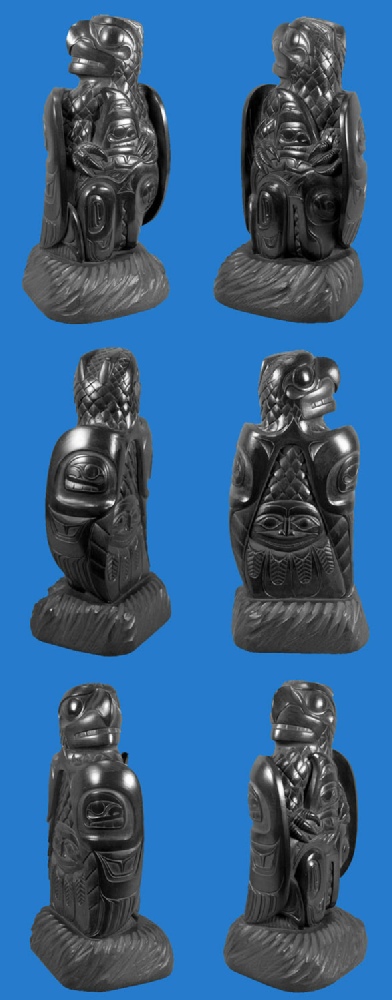Argillite Sculpture by Haida Artist Gary Minaker-Russ
Overview
Gary Minaker-Russ, a renowned Haida artist, has crafted a captivating argillite sculpture depicting a thunderbird capturing a killer whale. Known for his expertise in large argillite carvings, Gary’s work stands out for its intricate details and outstanding craftsmanship. This particular sculpture measures 10.8 inches in height, 5.3 inches in width, and 4.5 inches in depth, and is priced at $4800.
History of Haida Argillite Carving
For approximately 200 years, the Haida people have carved argillite sculptures, passing this tradition down through generations in the villages of Masset and Skidegate. The knowledge and techniques of older craftsmen have influenced contemporary artists, enabling them to create highly detailed and refined carvings. Additionally, artists source argillite, a type of slate rock, from Slatechuck Mountain near Skidegate on Haida Gwaii.
Key Points:
- Historical Legacy: Haida artists have carved argillite for over two centuries.
- Generational Knowledge: Older craftsmen have passed their skills to new generations in Masset and Skidegate.
- Material Source: Artists source argillite from Slatechuck Mountain near Skidegate on Haida Gwaii.
The Crafting Process
Artists create argillite sculptures using various tools, many of which are handmade. They begin by shaping the rock with coarse tools and then use progressively finer cutting tools. Next, they polish the sculpture with fine abrasives to remove tool marks. In recent years, some artists have incorporated inlay materials such as ivory, bone, abalone shell, paua shell, and catlinite to enhance the visual appeal of their works.
Crafting Steps:
- Tool Preparation: Artists often hand-make tools specifically for argillite carving.
- Shaping: Initially, artists shape the argillite using coarse tools.
- Detailing: Subsequently, they add intricate details with finer cutting tools.
- Polishing: They then use fine abrasives to polish the sculpture, ensuring a smooth finish.
- Inlay Work: Finally, some artists enhance their sculptures with inlays of materials like ivory and abalone shell.
Recent Trends
Over the past 50 years, Haida argillite sculptures have showcased remarkable craftsmanship. Artists continue to innovate by incorporating new materials and techniques while maintaining traditional practices. Consequently, this blend of old and new ensures that Haida argillite carving remains a vibrant and evolving art form.
Trends and Innovations:
- Incorporation of New Materials: Modern artists use materials like ivory, bone, and various shells for inlay work.
- Continued Excellence: The tradition of high-quality craftsmanship persists, with many artists achieving fine detail in their work.
Conclusion
In conclusion, Gary Minaker-Russ’s argillite sculpture of a thunderbird capturing a killer whale exemplifies the enduring legacy and evolving artistry of Haida argillite carving. With a rich history, a meticulous crafting process, and a blend of traditional and contemporary techniques, this art form continues to captivate and inspire.
For further reading, explore more about Haida argillite art in Leslie Drew’s book, Argillite: Art of the Haida, and learn about the tradition and recent works at Tribal Crafts.
Gary Minaker-Russ Haida
Thunderbird capturing a killer whale
Argillite –
$4800


